Chimera Organs?
The word chimera might get you thinking about the ancient greek monster, but the term has gained a whole new scientific meaning. Chimeras have always existed in the scientific community; the majority of chimeras are the result of different zygotes combining to create an organism with two different blood types or organs with different DNA. Salk Institute in California recently created a successful human-pig interspecies chimera. This is the first case in which human stem cells have grown successfully in another animal.
Previous similar experiments included growing a rat pancreas in a mouse without a pancreas. This mouse lived a healthy, long life with the rat pancreas working as a normal mouse pancreas.
These represent a small but impactful step towards growing and developing organs for human use. The current organ donation waiting list contains over 110,000 men, women, and children (according to organdoner.gov), and the ability to grow organs would greatly relieve the growing pressure on hospitals.
There are, however, ethical concerns with integrating human stems cells early into an animal embryo. Although human-animal chimeras have been used to show the progression of disease in organs, these human cells were introduced later in the animal’s gestation and had been more localized in their development of specialized organs. In the case of these pig embryos, the human stem cells were inserted much earlier in development and spread all throughout the pig body. Ethics experts worry that should the stem cells reach the brain and proceed to develop, it would create a humanized version of the pig. Should that happen, it would also raise the question of human rights and if such a creature should be given them. But in experiments so far, the stem cells have yet to reach the brain, and most ethics experts agree that the experiments have turned out to be a major scientific development. These reassurances from both the scientists and those concerned ethically may see more federal funding provided for the chimera experiments in the interest of developing a viable solution for organ development.
All in all, this research and the development in genetic manipulation and stem cells has opened the door for a new sector of scientific development that is sure to amaze.

Keeping it off the chizzain its Ryn, I love acapella singing and chilling at my house. Extremely vain and better than everyone.














Jessica Cox • Feb 16, 2017 at 12:37 pm
This is so crazy! Science has taken some huge leaps!
Morgan Gatlin • Feb 16, 2017 at 12:33 pm
Wow! This sounds like a very interesting experiment!
Megan Reynolds • Feb 16, 2017 at 12:30 pm
This is a very interesting article! It’s crazy how far science and technology is coming.